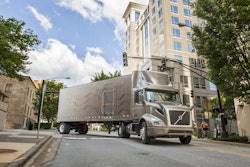 Next Trucking’s mobile app allows pre-approved truckers to instantly book freight.
Next Trucking’s mobile app allows pre-approved truckers to instantly book freight.The trucking and logistics industry has been inundated by well-funded startup brokerage firms. Many have developed software that makes freight and capacity available to carriers and shippers on-demand.
On-demand freight models seek to remove the role of an intermediary in freight transactions. Some refer to this “de-intermediation” movement as the “Uberization of trucking.”
In theory, technology should make it as easy to ship freight across the country as buying an item from Amazon or hailing a ride across town using the Uber app.
Automating truckload and less-than-truckload freight transactions may not be that easy, but startups believe the prospect is within reach.
Besides connecting all parties in the cloud and applying powerful freight matching algorithms, these models can eliminate faxing, emails, phone calls and other touch points in the lifecycle of shipments.
At least one company, Uber Freight, has its sights set on total automation using driverless trucks. When this day arrives truck capacity will truly be available on demand to shippers.
Uber has been sidetracked by legal battles but is still leading the race to autonomous trucking. In the meantime, high-tech brokers are looking for any advantage to make freight transactions more efficient for humans.
The challenge that all startups encounter is to attract and retain enough carriers and shippers to create a freight marketplace that adds value to both parties.
Next Trucking, a California-based startup, opened an on-demand freight shipping business in December, 2015. The company planned to offer coverage in all contiguous 48 states, but management soon realized this goal had to be postponed.
Motor carriers simply lost interest if freight didn’t meet their specific lane preferences. The company responded by making its technology and business model more trucker-centric, says Lidia Yan, chief executive office and co-founder of Next Trucking.
Owner operators and small carriers can use its mobile app and online platform to enter their route and rate preferences. Next Trucking uses this information to propose rates to shippers that have freight in truckers’ lanes of interest, she says.
Yan comes from a family business, iDC Logistics, that distributes TVs and consumer electronics from major ports in the United States to inland retailers. Next Trucking uses iDC’s contacts in the electronics industry to build its freight marketplace one lane at a time. It started with onboarding truckers based in southern California to pitch to shippers with outbound and inbound California lanes.
“We target a certain group of customers with quality freight,” she says. “Our existing relationships with shippers helped us build business really fast.”
To haul freight for Next Trucking, drivers are required to use its mobile app that automatically captures real-time shipment location using the GPS in smartphones. The app also has a document capture feature to upload proof-of-delivery receipts to expedite freight payment.
By using the online platform, carriers gain a free fleet management system to track shipments and monitor their business performance. Some truckers that work with Next Trucking put 100 percent of their capacity into the platform, Yan says.
“They decide where they want to go. They are always on their preferred lanes,” she says. By using a trucker-centeric approach to grow its business, Yan says the company is able to provide 98 percent coverage to the shippers that offer freight in lanes it serves.
Yan also noted that the company has a retention rate of 92 percent for drivers and 93 percent for shippers, and is currently doing over $2 million per month in revenue.
Looking ahead, she sees Next Trucking expanding its area focus to New Jersey and Texas, which are states with large ports. These two markets have high volumes of inbound and outbound shipments that will help the company build round trips for drivers based in the area.
“I know a lot of startups fail because they do not understand how important it is for drivers to always get loaded. We focus on drivers,” she says. “Our goal is to build a huge trucking fleet.”












